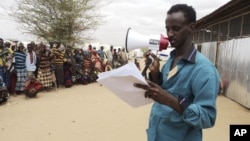GENEVA —
The United Nations refugee agency (UNHCR) reports the Dollo Ado complex in southeastern Ethiopia cannot keep pace with the continued influx of new refugees from Somalia.
Last week, its population surpassed the 170,000 mark. This, says U.N. refugee spokesman Andrej Mahecic, makes Dollo Ado the world's second largest refugee complex after the Dadaab site in Kenya.
"Although the rate of arrivals at Dollo Ado has slowed this year, people are continuing to flee conflict and insecurity in southern and central parts of Somalia," Mahecic said. "Many cite fear of harassment and forced recruitment by armed groups who still control large rural areas of Somalia... Their most urgent needs are emergency shelter, food and essential aid items," he said.
Ethiopia increasingly appears to be the destination of choice for Somali refugees, according to the UNHCR. It notes more than 25,000 of the estimated 62,000 Somalis who fled to countries in the region between January and the end of September headed for Ethiopia.
More than a million Somali refugees are already scattered across the Horn of Africa. To fully understand the magnitude of the Somali refugee crisis, one must realize that in the past decade, only the conflicts in Afghanistan and Iraq forced more than a million people to flee their homes.
More than half a million Somali refugees are in Kenya, while Ethiopia now hosts 214,000. The refugees are living in five overcrowded camps in Dollo Ado. A sixth site is being set up between the town of Kole and Kobe camp, some 54 kilometers north of Dollo Ado town, said Mahecic.
"The cost of the opening of the new site, setting up basic services and infrastructure including medical, education and warehousing facilities, is more than $5 million," he said. "We are seeking support from donors and partners, including resources for NGO [non-governmental organization] partners who would be working in the camp. For the initial phase, we urgently need $1.5 million simply for the site preparation, land demarcation and setting up basic infrastructure including bore holes, setting up water points, emergency clinic, latrines, etceteras."
A long-awaited 1,600-meter all-weather airstrip recently opened in Dollo Ado, Mahecic added, calling the development "great news" as it significantly upgrades access for humanitarian staff and transportation of cargo. Until now, aid agencies were forced to travel on poor roads, which severely delayed emergency interventions and urgent medical evacuations.
With the opening of the new airstrip, Mahecic said humanitarian agencies will now be able to deliver relief items to the refugees even in adverse weather conditions.
Last week, its population surpassed the 170,000 mark. This, says U.N. refugee spokesman Andrej Mahecic, makes Dollo Ado the world's second largest refugee complex after the Dadaab site in Kenya.
"Although the rate of arrivals at Dollo Ado has slowed this year, people are continuing to flee conflict and insecurity in southern and central parts of Somalia," Mahecic said. "Many cite fear of harassment and forced recruitment by armed groups who still control large rural areas of Somalia... Their most urgent needs are emergency shelter, food and essential aid items," he said.
Ethiopia increasingly appears to be the destination of choice for Somali refugees, according to the UNHCR. It notes more than 25,000 of the estimated 62,000 Somalis who fled to countries in the region between January and the end of September headed for Ethiopia.
More than a million Somali refugees are already scattered across the Horn of Africa. To fully understand the magnitude of the Somali refugee crisis, one must realize that in the past decade, only the conflicts in Afghanistan and Iraq forced more than a million people to flee their homes.
More than half a million Somali refugees are in Kenya, while Ethiopia now hosts 214,000. The refugees are living in five overcrowded camps in Dollo Ado. A sixth site is being set up between the town of Kole and Kobe camp, some 54 kilometers north of Dollo Ado town, said Mahecic.
"The cost of the opening of the new site, setting up basic services and infrastructure including medical, education and warehousing facilities, is more than $5 million," he said. "We are seeking support from donors and partners, including resources for NGO [non-governmental organization] partners who would be working in the camp. For the initial phase, we urgently need $1.5 million simply for the site preparation, land demarcation and setting up basic infrastructure including bore holes, setting up water points, emergency clinic, latrines, etceteras."
A long-awaited 1,600-meter all-weather airstrip recently opened in Dollo Ado, Mahecic added, calling the development "great news" as it significantly upgrades access for humanitarian staff and transportation of cargo. Until now, aid agencies were forced to travel on poor roads, which severely delayed emergency interventions and urgent medical evacuations.
With the opening of the new airstrip, Mahecic said humanitarian agencies will now be able to deliver relief items to the refugees even in adverse weather conditions.








